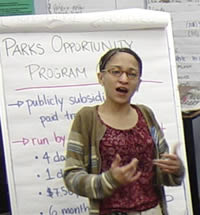 |
 |
This question is about figuring out what issues to tackle. How do organizers identify these issues? It depends on what kind of project it is.
The goal of nonpartisan political context analysis is to identify the needs and demands of the community that aren’t being met and to articulate those in words that will inspire as many people as possible to vote.
 Organization members + community members
Organization members + community membersLeadership may decide to shape the electoral work around the issues that the organization works on day in and day out, or may go to community members to learn what’s at the forefront of their minds as the election approaches. The best strategy is a combination of both, which may mean road-testing your organization’s key issues with a small pool of voters in order to gauge whether they are as important to the community as they are to your membership. Or it may mean that you ask community members to name their top priorities and then focus on those that share common ground with the work of your organization. In the video, Henry Serrano explains that Community Voices Heard has used both approaches.
In addition to the concerns voiced by membership and the community, organizers take into account the perceived wisdom about the election’s major issues – that is, how other actors in the political arena define the political context and how a particular constituency fits in.
There will be a lot said about the needs of the electorate – by the candidates, policy makers, religious leaders, journalists and pollsters, to name a few – and these are valuable sources of information, not least because they’re free and more or less readily available. But keep this in mind: as an experienced community organizer, you know your base better than just about anybody else. Why? Because everyone in the election game has an agenda, no data is wholly accurate and much of it is biased. Gather as much information as you can – you may use it again in the targeting phase – but consider it secondary to the first-hand experience of your membership and the community.
Robby Rodriguez describes in the video some of the sources of information that SouthWest Organizing Project uses to identify key issues. What’s crucial is that election organizers remain critical of the perceived wisdom about the election and their constituency, and compare a variety of perspectives.
If an organization has decided to get involved in a ballot initiative campaign it’s because they already know where they stand – they want to defeat a proposition limiting affirmative action or raise the minimum wage, for instance. Sometimes the issues are spelled out in the initiative itself and sometimes not. Bineshi describes how Sage Council was able to look at a street bonding issue and use it to prevent a road going through an ancient petroglyph site near Albuquerque
So the leadership of your organization grasps what’s at stake – but the membership may not. This is where issue education comes in. The goal here is to get the people already involved in your organization on board for the campaign, to generate a sense of urgency and a clear understanding of the issues that will power them through the months of campaigning. For instance: